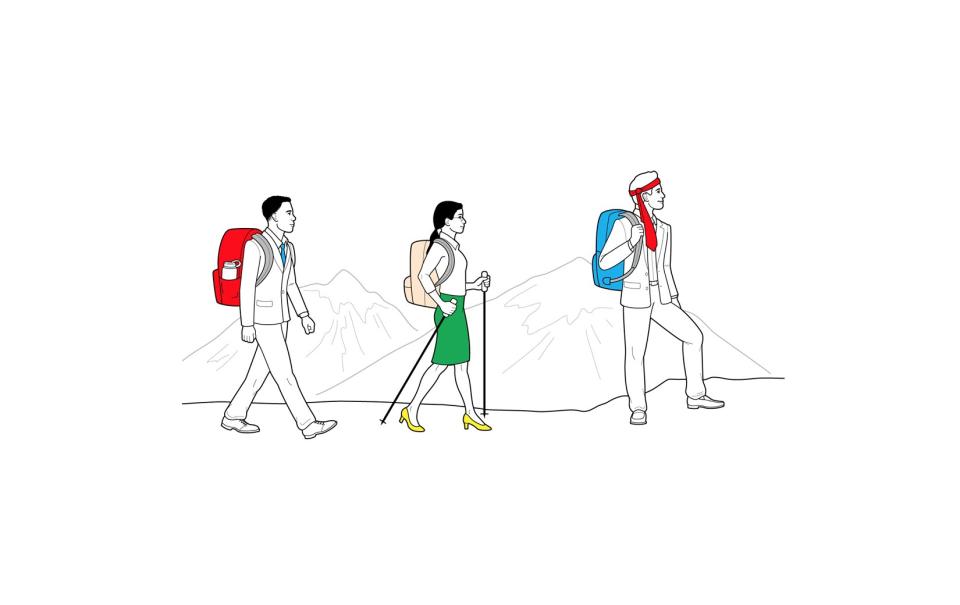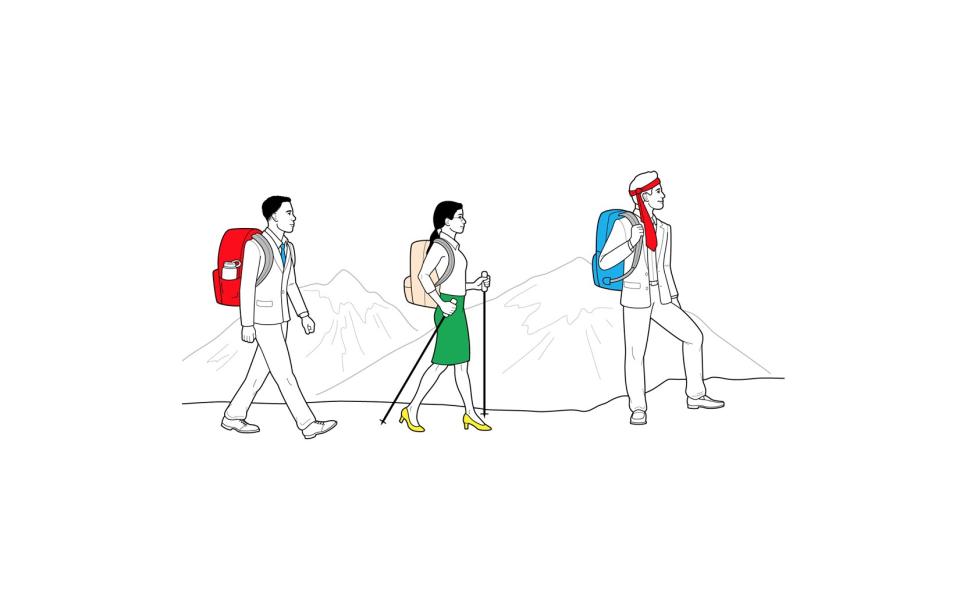Adventure Trips Are the New Business Dinners

For Tom Hogan, chairman and CEO of Kony, Inc., an enterprise mobility company based in Austin, Texas, work dinners lost their lure years ago.
“At some point, most people in the corporate world have been to a million four-star restaurants,” he says. “It gets old. People quasi-resent the forced march of the old, tired approach.”
That’s why he’s looked far beyond set tables to build a close-knit business team—to whitewater rafting trips along West Virginia’s wild Upper Gauley River, ski outings with former Olympians, and midnight snowmobiling tours through the Rocky Mountains. Hogan has been embarking on such adventure retreats for close to 20 years now. He's not alone.
“More and more, organizations are using adventures, either real or virtual, to anchor their business messaging,” says Shane Toohey, founder of leadership development company Peak Teams, a company that films real-life adventures like mountaineering, sailing or traversing wild, remote terrain, then uses them as in-office simulations to build business skills for clients. The company presents real-life footage from, say, climbing New Zealand's treacherous Mount Cook range, pausing to present obstacles, challenges, and decisions to groups that then use the simulation to figure out how to move forward.
Similarly, companies such as California-based Adventure Out, Outward Bound Professional, and—as of just this year—retail company Life Is Good all curate corporate outdoor adventure trips worldwide.
Rappelling waterfalls in Costa Rica can give way to conversations about teamwork and trust; sailing the Florida Keys might present a scenario like the need to anchor a boat for the first time—then a conversation about what to do when a project launch doesn’t quite go off without a hitch, says Cindy Makin Brown, operations coordinator for Outward Bound Professional, the corporate retreat arm of the wilderness company that serves global and regional businesses alike.
These trips pull in CEOs and executives, people who tend to share a set of personality traits. “People who love the challenge of extreme adventures are typically of the same mindset as those who rise up the ranks in business,” says Toohey, a ski mountaineer who’s explored all seven continents. “They’re driven, motivated, and goal-oriented.”
There are a lot of personas that get projected inside of workplaces. We can help push those personas to the side.
One of the first questions Outward Bound Professional asks potential corporate clients is: What are your main goals? Responses tend to be similar—people want to build relationships, grow trust, and get to know each other better.
“At some level [corporations] are trying to access authenticity in their employees,” says Andrew Spofford, director of Outward Bound Professional. “There are a lot of personas that get projected inside of workplaces. We can help push those personas to the side.”
Natural environments are good at doing just that. Years of research demonstrate the Great Outdoors works to reduce levels of stress, freeing areas of the brain involved in engagement, arousal, and creativity. It also quiets brain regions that make us frustrated, worried, or absent to the present moment. Other studies have demonstrated more: that being exposed to awe-inducing spaces—mountains, oceans, remote corners of the planet—can make people more generous, trusting, and helpful.
Extracting yourself from the daily interruptions of phone calls and emails can build in time for reflection, too—key for executives in high-stress jobs that never quite quit.
“I think it's healthy to continue to ask yourself, Am I happy with the way I perform?” says Tom O’Reilly, a Seattle-based Microsoft executive who’s traveled the world for both business and adventure and, this month, will embark on a 60-mile ski traverse of Baffin Island in the Canadian High Arctic with Peak Teams for use in a future simulation. “When you’re in the thick of it, it’s too easy to not take a step back and do that.”
Too, an adventure trip also offers that chance to prove that you still have what it takes to perform in a volatile environment of change and ambiguity, says Toohey. “Nothing can stand in the way—sweat, tears, and maybe a little blood are all part of the story.”
For those who make the trips habit, the results are clear.
On dozens of different occurrences, Hogan has seen rival executives reach a new I've-got-your-back,-how-can-I-help? type of understanding and trust post-trip that comes only from relying on someone to do their share riding rapids or being someone’s belayer during a rock climbing outing.
“It’s magical to watch bridges form, relationships built, and trusts established in these sort of semi-extreme environments that then spill over almost immediately into the workplace,” he says.
And after travel outings where team pow-wows happen in small circles, Makin Brown has had executives tell her that they bought large circular tables, doing away with individual desks to promote teamwork (something research suggests works).
“The impact is often almost immediate,” Hogan says. “That’s really the crux of why you do it.”
Real-life or simulated, travel excursions also reaffirm the reality of consequences. “In life and in business, we’re not always right,” says Hogan. And on an extreme trip, you’re truly forced to weigh all options and put thought into the decision-making process. Sometimes, as extreme athletes and travelers know, it's life or death.
Of course, beyond a bottom-line influence on business or personal growth, adventure travel hits a more human note for businesspeople, too: “We all have a spirit of adventure,” says Hogan. And besides salary or an open workspace, there’s something else involved in employee retention: the realization that it’s fun to be a part of your team—that you don’t want to leave; you want to keep exploring.
As he puts it: “While everyone else goes out to dinner, we go for midnight snowmobile rides.”


